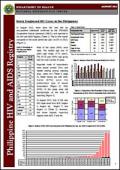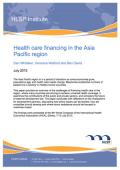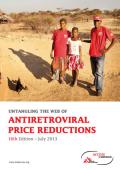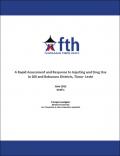What's New
Displaying results 3471 - 3480 of 4914

Resource | Fact Sheets,
In August 2013, there were 382 new HIV Ab sero-positive individuals confirmed by the STD/AIDS Cooperative Central Laboratory (SACCL) and reported to the HIV and AIDS Registry (Table 1). This is 40% higher compared to the same period last year (n=272 in 2012).

Resource | Publications,
This paper provides an overview of the challenges of financing health care in the region, where many countries are striving to achieve universal health coverage. It examines the contributions of the public and private sectors, and considers the future of external development aid. The paper concludes with reflections on the implications for development partners, discussing how policy issues can be tackled, how aid modalities should develop and where donor assistance should be focused to maximise impact.

Resource | Publications,
Over the past 13 years, the MSF Access Campaign has been monitoring the patent barriers, prices and availability of ARVs through Untangling the Web and pushing for the uptake of policies that promote access to affordable quality medicines. Due primarily to generic competition, the price of ARVs has dropped by more than 99% over the last decade, but the price of the newest drugs, already needed by some people in MSF projects, is prohibitive and a source of great concern both for MSF and for national treatment programmes.
Resource | Videos,
Video of the presentation by By Mr. J.V.R. Prasada Rao United Nations Secretary-General’s Special Envoy for AIDS in Asia and the Pacific, at the 7th IAS Conference on HIV Pathogenesis, Treatment and Prevention
Resource | Videos,
Tracking the HIV/AIDS Epidemic in Asia and the Pacific from AIDS Data Hub on Vimeo.
7th IAS Conference on HIV Pathogenesis, Treatment and Prevention
By Mr. J.V.R. Prasada Rao United Nations Secretary-General’s Special Envoy for AIDS in Asia and the Pacific
3 July 2013 Kuala Lumpur, Malaysia

Resource | Publications,
This study was based on the Rapid Assessment and Response methodology outlined in the WHO Rapid Assessment and Response Guide on Psychoactive Substance Use and Sexual Risk Behaviour and the WHO Rapid Assessment and Response Technical Guide on Injecting and Drug Use. Both qualitative and quantitative research methods were used. 17 Key informant interviews, 15 focus group discussions, and 44 individual structured interviews among drug users were conducted.

Resource | Publications,
The donor landscape for HIV/AIDS is varied and complex, with multiple donors providing assistance to many different regions and countries, and an average of 10 donors providing aid for HIV per recipient country. Despite the high number of donors in this space, however, the actual amount of funding provided for HIV/AIDS is concentrated among a small number of donors, with just two – the United States and the Global Fund to Fight AIDS, Tuberculosis and Malaria (Global Fund) – accounting for 80% of funding.

Resource | Publications,
The United Nations Security Council (UNSC) Resolution 1983 was adopted in June 2011 just before the United Nations (UN) General Assembly High Level Meeting (HLM) agreed the Political Declaration: Intensifying Our Efforts To Eliminate HI and AIDS including ten global targets to achieve by 2015 ("HLM targets").
Together, the HLM targets and UNSC Resolution 1983 provide an opportunity to scale up universal access to HIV and AIDS related services for all uniformed service personnel and their family members and for people living with HIV and the key populations at higher risk of HIV with whom uniformed services personnel interact. In Asia and the Pacific, key populations include sex workers, men who have sex with men, people who inject drugs, transgender people, migrants and mobile populations, prisoners, internally and externally displaced people due to humanitarian situations and those at risk of sexual violence.

Resource | Publications,
This publication reports on the progress being made in the global scale-up in the use of antiretroviral (ARV) medicines in low- and middle-income countries, the challenges that are being overcome or that await solutions and the opportunities for building on the achievements of the past decade.

Resource | Publications,
Sexually transmitted infections (STIs) are present at high levels in the Pacific, with many countries having Chlamydia rates of >20% among antenatal clinic (ANC) clients. The current assessment examined the STI interventions implemented in Fiji and Vanuatu.
Both Fiji and Vanuatu would benefit from the increased use of STI (not just HIV) messages in their health communication and HIV prevention efforts. There is also a need to strengthen targeted interventions for HIV and STIs among the key populations at higher risk (KPHR) such as better linkages between civil society peer and outreach and government services, addressing laws that impede access by HPHR and strengthen condom programming. Fiji in particular could make greater use of its NGOs to strengthen targeted interventions for HIV and STIs among key populations at higher risk. Finally, the STI response should be monitored more intensively, including efforts to quantitate the success of partner treatment and syphilis screening efforts.





